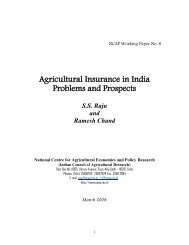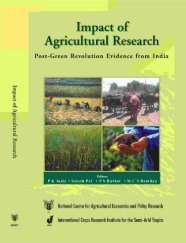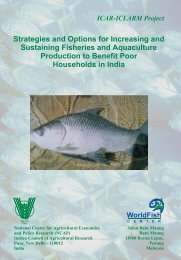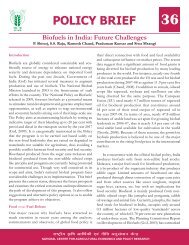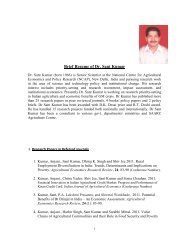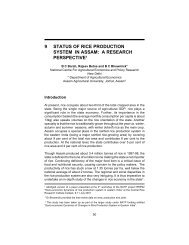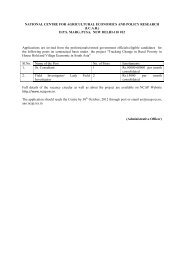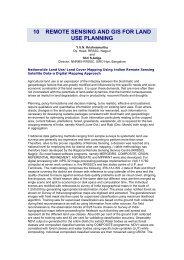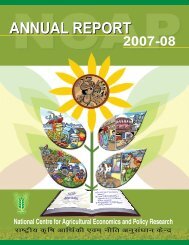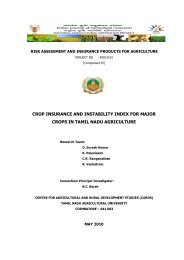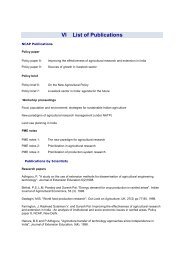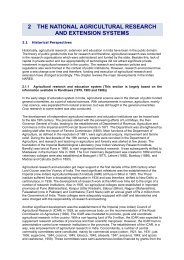Instability in Indian Agriculture - NCAP
Instability in Indian Agriculture - NCAP
Instability in Indian Agriculture - NCAP
Create successful ePaper yourself
Turn your PDF publications into a flip-book with our unique Google optimized e-Paper software.
<strong>Instability</strong> <strong>in</strong> <strong>Indian</strong> <strong>Agriculture</strong><br />
is slope) and de-trend the series. This is done by comput<strong>in</strong>g residuals [e t<br />
=Y-(a+bT)], i. e. deviations between actual and estimated trend values,<br />
and estimat<strong>in</strong>g <strong>in</strong>stability based on e t<br />
. As mean of e t<br />
is always zero, their<br />
standard deviation is used to measure <strong>in</strong>stability. The ma<strong>in</strong> problem with<br />
this is comparability across data sets hav<strong>in</strong>g different mean values. This<br />
necessitates use of coefficient of variation, <strong>in</strong>stead of standard deviation,<br />
to measure dispersion. As “mean” of detrended residuals is zero, it is<br />
not possible to compute CV of residuals (e t<br />
), however, researchers have<br />
developed some methods to compute CV that is based on residuals.<br />
Mehra (1981) used standard deviation <strong>in</strong> residuals divided by mean of the<br />
variable (Area, production or yield) to compute and compare <strong>in</strong>stability <strong>in</strong><br />
agricultural production before and after <strong>in</strong>troduction of new technology.<br />
The author termed the estimate as coefficient of variation even though it<br />
does not follow standardized def<strong>in</strong>ition of CV. 4 Hazell (1982) developed<br />
a new method to make use of residuals to estimate <strong>in</strong>stability, which was<br />
slightly different than the measure developed by Mehra (1981). Hazell<br />
detrended the data and constructed a variable (Z t<br />
) which was computed<br />
by add<strong>in</strong>g mean of the dependent variable to residuals e t<br />
as under: Z t<br />
=e t<br />
+⎺Y. Coefficient of variation of Z t<br />
was used as a measure of <strong>in</strong>stability 5 .<br />
The measures of <strong>in</strong>stability proposed by Mehra (1981) and Hazell (1982)<br />
are based on detrended data, they are unit free and imparts comparability.<br />
However, these methodologies have been criticized for measur<strong>in</strong>g<br />
<strong>in</strong>stability around an arbitrarily assumed trend l<strong>in</strong>e which greatly <strong>in</strong>fluences<br />
<strong>in</strong>ference regard<strong>in</strong>g changes <strong>in</strong> <strong>in</strong>stability 6 (Ray 1983a p. 463).<br />
Ray (1983b) developed a very simple measure of <strong>in</strong>stability given by<br />
standard deviation <strong>in</strong> annual growth rates. The method satisfies the<br />
properties like <strong>in</strong>stability based on detrended data and comparability.<br />
Moreover, the methodology does not <strong>in</strong>volve actual estimation of trend,<br />
computation of residuals and detrend<strong>in</strong>g, but all these are taken care <strong>in</strong><br />
the standard deviation of annual growth rate. This method also does not<br />
suffer from the limitations like arbitrary choice of assumed trend l<strong>in</strong>e<br />
4Also see footnote 1.<br />
5Also see footnote 2.<br />
6 For <strong>in</strong>stance, manipulation of residuals e t<br />
by add<strong>in</strong>g mean¯Y implies that detrend<strong>in</strong>g is done<br />
around sum of estimated/trend value ÿ and ¯Y <strong>in</strong>stead of do<strong>in</strong>g it around ÿ alone. The variable<br />
Z constructed by add<strong>in</strong>g¯Y to e t<br />
do not satisfy statistical criteria of best fit.<br />
... 10 ...



